Pre-eclampsia, Eclampsia > Maternal & Newborn
Exam Review
Clinical Features
Total Questions : 16
Showing 16 questions, Sign in for moreA nurse is caring for a client with mild pre-eclampsia who has a blood pressure of 150/95 mmHg, proteinuria of 400 mg/24 hours, and edema of the face and hands.
Which intervention is the priority for this client?
Explanation
Encourage bed rest in a left lateral position.
This is because bed rest can lower blood pressure and improve blood flow to the placenta and the fetus.The left lateral position reduces pressure on the inferior vena cava, a large vein that carries blood from the lower body to the heart.
Choice A is wrong because magnesium sulfate is used to prevent seizures in severe preeclampsia or eclampsia, not mild preeclampsia.
Choice B is wrong because monitoring the fetal heart rate and movement is important, but not the priority for this client.
Choice D is wrong because educating the client about the signs of eclampsia is not urgent and may not prevent the progression of preeclampsia.Some signs of eclampsia are severe headaches, blurred vision, nausea, vomiting, abdominal pain and seizures.
A nurse is caring for a client with mild pre-eclampsia who has a blood pressure of 150/95 mmHg, proteinuria of 400 mg/24 hours, and edema of the face and hands.
Which intervention is the priority for this client?
Explanation
This is because bed rest can lower blood pressure and improve blood flow to the placenta and the fetus.The left lateral position reduces pressure on the inferior vena cava, a large vein that carries blood from the lower body to the heart.
Choice A is wrong because magnesium sulfate is used to prevent seizures in severe preeclampsia or eclampsia, not mild preeclampsia.
Choice B is wrong because monitoring the fetal heart rate and movement is important, but not the priority for this client.
Choice D is wrong because educating the client about the signs of eclampsia is not urgent and may not prevent the progression of preeclampsia.Some signs of eclampsia are severe headaches, blurred vision, nausea, vomiting, abdominal pain and seizures.
A nurse is reviewing the laboratory results of a client with severe pre-eclampsia who is receiving magnesium sulfate.
Which finding would indicate a therapeutic level of magnesium sulfate?
Explanation
This indicates a therapeutic level of magnesium sulfate for a client with severe pre-eclampsia who is receiving magnesium sulfate.According to some sources, the effective therapeutic serum magnesium level is 1.8–3.0 mmol/L, which corresponds to 4.2–7 mg/dL or 3.5–7 mEq/L.
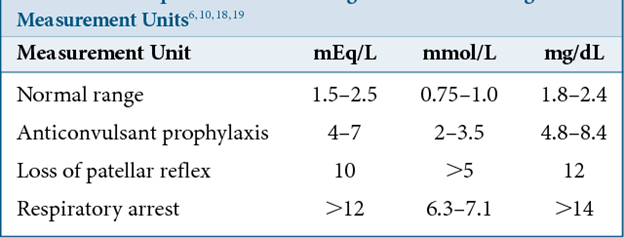
Choice B is wrong because serum calcium level of 8.5 mg/dL is within the normal range and does not indicate the effect of magnesium sulfate.
Choice C is wrong because serum creatinine level of 1.2 mg/dL is within the normal range and does not indicate the effect of magnesium sulfate.
Choice D is wrong because serum potassium level of 3.5 mEq/L is at the lower end of the normal range and does not indicate the effect of magnesium sulfate.
A nurse is preparing to administer hydralazine to a client with pre-eclampsia who has a blood pressure of 180/110 mmHg.
What is the rationale for using this medication?
Explanation
This is the rationale for using this medication in a client with pre-eclampsia who has a blood pressure of 180/110 mmHg.High blood pressure in pre-eclampsia can cause damage to the kidneys, liver, brain, and other organs, and can also increase the risk of complications for the baby.
Therefore, lowering blood pressure with hydralazine can help prevent or reduce these adverse outcomes.
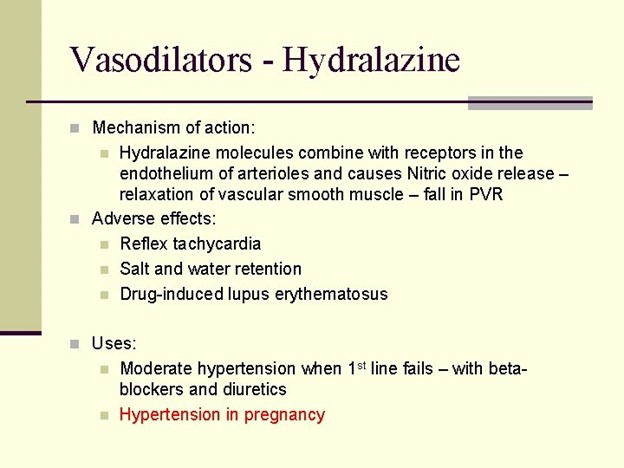
Choice A is wrong because hydralazine does not reduce cerebral edema or prevent seizures.These are symptoms of eclampsia, a more severe form of pre-eclampsia that requires different treatment.
Choice B is wrong because hydralazine does not increase uteroplacental perfusion or fetal oxygenation.These are affected by other factors such as the placental function, maternal position, and fetal well-being.
Choice C is wrong because hydralazine does not decrease proteinuria or prevent renal damage.
Proteinuria is a sign of kidney impairment that occurs in pre-eclampsia, but it is not directly affected by hydralazine.Renal damage can be prevented by controlling blood pressure and avoiding nephrotoxic drugs.
A nurse is assessing a client with pre-eclampsia who is receiving oxytocin for labor induction.
Which finding would alert the nurse to suspect that the client is developing HELLP syndrome?
Explanation
This is because HELLP syndrome is a complication of pregnancy that affects the liver and blood clotting.It can cause liver damage, bleeding problems, and high blood pressure.Epigastric pain or right upper quadrant pain is a sign of liver injury or rupture.
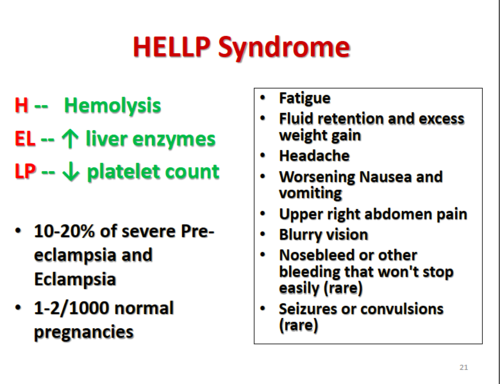
Choice B is wrong because blurred vision or flashes of light are symptoms of preeclampsia, not HELLP syndrome.
Preeclampsia is a condition that causes high blood pressure and protein in the urine during pregnancy.It can lead to HELLP syndrome, but not all women with preeclampsia develop HELLP syndrome.
Choice C is wrong because decreased urinary output or oliguria are also symptoms of preeclampsia, not HELLP syndrome.
Oliguria means producing less than 400 mL of urine in 24 hours.It can indicate kidney damage or failure due to high blood pressure or proteinuria.
Choice D is wrong because hyperreflexia or clonus are also symptoms of preeclampsia, not HELLP syndrome.
Hyperreflexia means having exaggerated reflexes, while clonus means having involuntary muscle spasms.
They can indicate nervous system involvement or seizures due to high
A nurse is providing discharge instructions to a client who had pre-eclampsia and delivered a healthy baby.
Which statement by the client indicates a need for further teaching?
Explanation
The client should not resume normal activities as soon as she gets home because she is still at risk for complications from preeclampsia.She should rest as directed by her healthcare provider and avoid strenuous activities that may increase her blood pressure.
Choice A is wrong because monitoring blood pressure at home is a recommended practice for clients who had preeclampsia.It can help detect any signs of worsening hypertension or organ damage.
Choice B is wrong because reporting any headache, vision changes, or abdominal pain to the doctor is a crucial step to prevent serious complications from preeclampsia.These symptoms may indicate damage to the brain, eyes, or liver and require immediate medical attention.
Choice D is wrong because continuing to take prenatal vitamins and iron supplements is beneficial for the client’s recovery and health.Prenatal vitamins can provide essential nutrients that may be lacking in the diet, and iron supplements can prevent or treat anemia that may result from blood loss during delivery.
A nurse is caring for a client with severe pre-eclampsia who is receiving magnesium sulfate.
Which of the following findings would indicate magnesium toxicity and require immediate intervention?
Explanation
A. Urinary output of 25 mL/hour.This indicates magnesium toxicity and requires immediate intervention because it means the kidneys are not functioning properly and magnesium is not being excreted.Magnesium toxicity can cause life-threatening complications such as respiratory depression, cardiac arrest, and coma.
B. Respiratory rate of 14 breaths/minute is normal and does not indicate magnesium toxicity.A respiratory rate of less than 12 breaths/minute or more than 20 breaths/minute would be abnormal and require further assessment.
C. Deep tendon reflexes 1+ are normal and do not indicate magnesium toxicity.A loss of deep tendon reflexes or clonus would indicate magnesium toxicity and require immediate intervention.
D. Serum magnesium level of 6 mg/dL is within the therapeutic range for preeclampsia and does not indicate magnesium toxicity.
The therapeutic range for preeclampsia is 4 to 7 mg/dL.A serum magnesium level of more than 8 mg/dL would indicate magnesium toxicity and require immediate intervention.
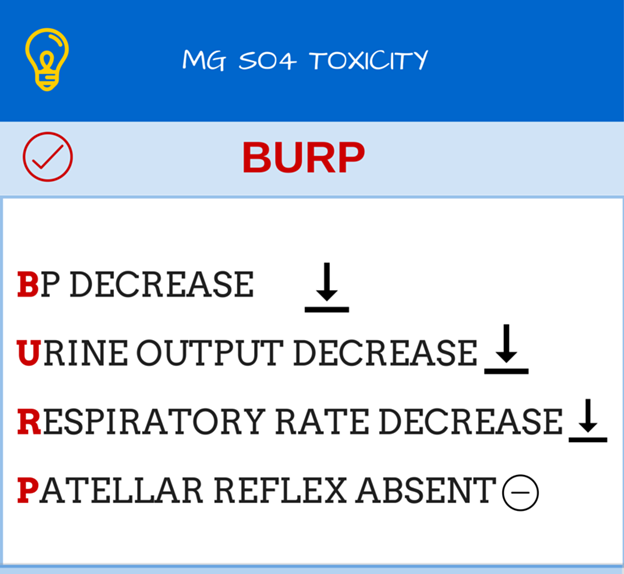
A nurse is assessing a client with severe pre-eclampsia who reports a severe headache and blurred vision.
The nurse notes that the client has hyperreflexia with clonus.
What is the most likely explanation for these findings?
Explanation
The most likely explanation for the client's findings of severe headache, blurred vision, hyperreflexia, and clonus in the context of severe pre-eclampsia is A. Cerebral edema.
Pre-eclampsia is a pregnancy-related condition characterized by high blood pressure (hypertension) and signs of organ damage, most commonly affecting the liver and kidneys. Severe pre-eclampsia can lead to complications such as eclampsia, which is characterized by seizures. The symptoms described by the client, including severe headache and blurred vision, are consistent with neurological manifestations associated with severe pre-eclampsia.
Hyperreflexia refers to an exaggerated reflex response, and clonus refers to rhythmic contractions of a muscle when it is passively stretched. Both hyperreflexia and clonus are indicative of central nervous system (CNS) hyperexcitability. Cerebral edema, which is the swelling of the brain due to fluid accumulation, can lead to increased intracranial pressure and neurological symptoms such as headache, vision changes, hyperreflexia, and clonus.
While other complications such as pulmonary edema (B), hemolysis (C), and thrombocytopenia (D) can occur in severe pre-eclampsia, they are not directly associated with the reported symptoms of severe headache, blurred vision, hyperreflexia, and clonus.
Pre-eclampsia is a pregnancy-related condition characterized by high blood pressure (hypertension) and signs of organ damage, most commonly affecting the liver and kidneys. Severe pre-eclampsia can lead to complications such as eclampsia, which is characterized by seizures. The symptoms described by the client, including severe headache and blurred vision, are consistent with neurological manifestations associated with severe pre-eclampsia.
Hyperreflexia refers to an exaggerated reflex response, and clonus refers to rhythmic contractions of a muscle when it is passively stretched. Both hyperreflexia and clonus are indicative of central nervous system (CNS) hyperexcitability. Cerebral edema, which is the swelling of the brain due to fluid accumulation, can lead to increased intracranial pressure and neurological symptoms such as headache, vision changes, hyperreflexia, and clonus.
While other complications such as pulmonary edema (B), hemolysis (C), and thrombocytopenia (D) can occur in severe pre-eclampsia, they are not directly associated with the reported symptoms of severe headache, blurred vision, hyperreflexia, and clonus.
A nurse is reviewing the laboratory results of a client with severe pre-eclampsia.
Which of the following results would indicate hepatic involvement? (Select all that apply.)
Explanation
The correct answer is choice B, C and D. These results indicate hepatic involvement because they are elevated above the normal ranges.According to, the normal ranges for AST, ALT and LDH are:
• AST: 8 to 48 U/L
• ALT: 7 to 55 U/L
• LDH: 122 to 222 U/L
Choice A is wrong because serum creatinine is not a marker of liver function, but of kidney function.The normal range for serum creatinine is 0.6 to 1.3 mg/dL for adults.
Choice E is wrong because platelet count is not a marker of liver function, but of blood clotting ability.The normal range for platelet count is 150 to 450 x 10^9/L.
A nurse is preparing to administer hydralazine to a client with severe pre-eclampsia who has a blood pressure of 170/110 mmHg.
What is the expected outcome of this medication?
Explanation
To lower blood pressure.Hydralazine is an antihypertensive drug that is used to treat severe hypertension in pre-eclampsia.It works by relaxing the blood vessels and reducing the resistance to blood flow.
This helps to lower the blood pressure and prevent complications such as stroke, kidney damage, or placental abruption.
Choice A is wrong because hydralazine does not prevent seizures.
Seizures are a symptom of eclampsia, a more severe form of pre-eclampsia.To prevent seizures, magnesium sulfate is usually given intravenously.
Choice C is wrong because hydralazine does not increase urine output.In fact, it may cause fluid retention and edema as a side effect.Diuretics are drugs that increase urine output, but they are not recommended for pre-eclampsia because they may worsen the condition by reducing blood volume and placental perfusion.
Choice D is wrong because hydralazine does not improve placental perfusion.
Placental perfusion is the blood flow to the placenta, which provides oxygen and nutrients to the fetus.
Placental perfusion may be impaired in pre-eclampsia due to abnormal development of the placental blood vessels.Hydralazine does not affect the placental blood vessels directly, but it may improve placental perfusion indirectly by lowering the maternal blood pressure and reducing the risk of abruption.
However, this is not the primary or expected outcome of hydralazine therapy.
A nurse is educating a client with mild pre-eclampsia about the signs and symptoms that she should report to her health care provider.
Which of the following should the nurse include? (Select all that apply.)
Explanation
The correct answer is choice C and D.Epigastric pain and decreased fetal movement are signs of severe pre-eclampsia that indicate damage to the liver and placenta respectively.These symptoms should be reported to the health care provider immediately as they may lead to serious complications such as eclampsia, HELLP syndrome, placental abruption or fetal growth restriction.
Choice A is wrong because sudden weight gain is a common symptom of mild pre-eclampsia that does not necessarily require immediate attention.However, it should be monitored regularly along with blood pressure and urine protein levels.
Choice B is wrong because swelling of the face and hands is also a common symptom of mild pre-eclampsia that does not indicate severe organ damage.It may be caused by fluid retention or edema.
Choice E is wrong because vaginal bleeding is not a typical symptom of pre-eclampsia.It may be a sign of other pregnancy complications such as placenta previa, placental abruption or cervical infection.
A nurse is caring for a client who has severe preeclampsia and is receiving magnesium sulfate infusion.
Which of the following assessments is most important for the nurse to monitor?
Explanation
Deep tendon reflexes.
The nurse should monitor the client’s deep tendon reflexes to assess for signs of magnesium toxicity, which can cause respiratory depression, cardiac arrest, and coma.Magnesium sulfate is given to prevent seizures in clients with severe preeclampsia, but it can also have adverse effects on the neuromuscular system.
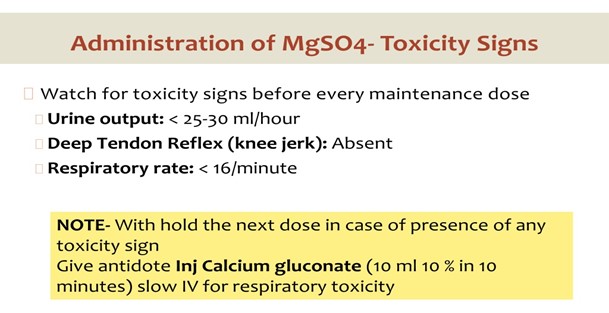
Choice A is wrong because blood pressure is not the most important assessment for a client receiving magnesium sulfate.
Blood pressure is a manifestation of preeclampsia, but it does not indicate magnesium toxicity.
Choice B is wrong because urine output is not the most important assessment for a client receiving magnesium sulfate.
Urine output should be at least 25 to 30 mL/hr to promote adequate excretion of magnesium, but it does not reflect the level of magnesium in the blood.
Choice D is wrong because fetal heart rate is not the most important assessment for a client receiving magnesium sulfate.
Fetal heart rate is important to monitor for signs of fetal distress, but it does not indicate maternal magnesium toxicity.
A client who is 36 weeks pregnant is admitted to the hospital with a diagnosis of eclampsia.
She has a history of chronic hypertension and gestational diabetes.
The nurse anticipates that the client will receive which of the following medications to prevent seizures?
Explanation
Magnesium sulfate.Magnesium sulfate is thedrug of choiceto prevent and treat seizures in people with severe preeclampsia and eclampsia.It is an anticonvulsant medication that reduces the risk of eclampsia by 50%.
Choice A is wrong because hydralazine is a blood pressure medication that can lower blood pressure in people with preeclampsia or eclampsia, but it does not prevent seizures.
Choice B is wrong because nifedipine is another blood pressure medication that can lower blood pressure in people with preeclampsia or eclampsia, but it does not prevent seizures.
Choice D is wrong because diazepam is an anticonvulsant medication that was previously used to treat eclamptic seizures, but it has been replaced by magnesium sulfate as the preferred drug due to its better safety and efficacy.Diazepam can also cause sedation and respiratory depression in the mother and the fetus.
Normal ranges for blood pressure are below 140/90 mm Hg, for proteinuria are below 300 mg/24 hours, for platelet count are 150,000 to 450,000 per microliter, for liver enzymes are 7 to 56 units per liter for alanine aminotransferase (ALT) and 10 to 40 units per liter for aspartate aminotransferase (AST), and for magnesium levels are 1.5 to 2.5 mEq/L.
A nurse is reviewing the laboratory results of a client who has mild preeclampsia.
Which of the following findings would indicate a need for further evaluation?
Explanation
Serum creatinine of 1.2 mg/dL.This indicates a need for further evaluation because it is above the normal range of 0.6 to 1.1 mg/dL for women and suggests kidney impairment.Preeclampsia can affect the kidneys and other organs.
Choice A is wrong because a platelet count of 150,000/mm3 is within the normal range of 150,000 to 450,000/mm3.
Choice C is wrong because proteinuria of 1+ on dipstick is expected in mild preeclampsia.
Choice D is wrong because serum albumin of 3.5 g/dL is within the normal range of 3.4 to 5.4 g/dL.
A nurse is providing discharge teaching to a client who had preeclampsia and delivered a healthy baby at 38 weeks of gestation.
Which of the following instructions should the nurse include in the teaching?
Explanation
Report any headache that is not relieved by acetaminophen.This is because a headache that persists despite taking pain medication can be a sign of increased blood pressure or brain swelling, which are serious complications of preeclampsia.
Choice B is wrong because some vaginal bleeding for up to 6 weeks postpartum is normal and expected for any woman who has given birth, regardless of whether she had preeclampsia or not.
Choice C is wrong because resuming sexual activity as soon as you feel comfortable is also a normal recommendation for any woman who has given birth, unless there are other medical reasons to avoid it.
Choice D is wrong because drinking at least 3 liters of fluid per day to prevent dehydration is not necessary for a woman who had preeclampsia.In fact, drinking too much fluid can worsen the swelling and fluid retention that are common in preeclampsia.
(Select all that apply) A nurse is assessing a client who is 32 weeks pregnant and has a diagnosis of severe preeclampsia.
Which of the following findings should the nurse report to the provider immediately?
Explanation
The correct answer is choice A, B, D and E. These are all signs of severe preeclampsia that indicate organ damage and require immediate medical attention.According to Mayo Clinic, preeclampsia is a complication of pregnancy that causes high blood pressure, protein in the urine, or other signs of organ damage after 20 weeks of gestation.
Choice A is correct because epigastric pain can indicate liver damage or bleeding in the abdomen due to preeclampsia.
Choice B is correct because blurred vision or light sensitivity can indicate brain damage or increased pressure in the skull due to preeclampsia.
Choice C is wrong because facial edema is a common symptom of normal pregnancy and does not necessarily indicate preeclampsia.
Choice D is correct because hyperreflexia can indicate nervous system damage or increased pressure in the skull due to preeclampsia.
Choice E is correct because oliguria can indicate kidney damage or decreased blood flow to the kidneys due to preeclampsia.
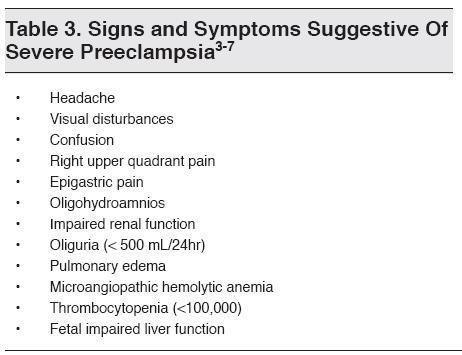
Sign Up or Login to view all the 16 Questions on this Exam
Join over 100,000+ nursing students using Nursingprepexams’s science-backend flashcards, practice tests and expert solutions to improve their grades and reach their goals.
Sign Up Now

